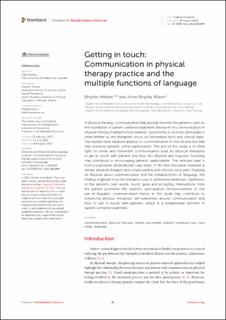| dc.contributor.author | Ahlsen, Birgitte | |
| dc.contributor.author | Nilsen, Anne Birgitta | |
| dc.date.accessioned | 2022-10-07T14:32:56Z | |
| dc.date.available | 2022-10-07T14:32:56Z | |
| dc.date.created | 2022-08-08T09:57:45Z | |
| dc.date.issued | 2022-08-04 | |
| dc.identifier.issn | 2673-6861 | |
| dc.identifier.uri | https://hdl.handle.net/11250/3024565 | |
| dc.description.abstract | In physical therapy, communication that actively involves the patient is seen as the foundation of patient-centered treatment. Research on communication in physical therapy highlights how patients’ opportunity to actively participate is often limited by the therapists’ focus on biomedical facts and clinical tasks. Few studies have explored aspects of communication in clinical practice that may promote patients’ active participation. The aim of this study is to shed light on verbal and nonverbal communication used by physical therapists to get in touch with patients and how this physical and linguistic touching may contribute to encouraging patients’ participation. The selected case is from a qualitative observational case study of the first encounter between a female physical therapist and a male patient with chronic neck pain. Drawing on theories about communication and the metafunctions of language, the findings highlight how the therapist’s use of unfinished sentences, repetitions of the patient’s own words, touch, gaze and accepting interruptions from the patient promotes the patient’s participation. Demonstrations of the use of linguistic communication theory in this study may contribute to enhancing physical therapists’ self-awareness around communication and how to get in touch with patients, which is a fundamental element in patient-centered treatment. | en_US |
| dc.description.sponsorship | Funding provided by the Norwegian Fund for Post-Graduate Training in Physiotherapy, Grant No. 45027. | en_US |
| dc.language.iso | eng | en_US |
| dc.publisher | Frontiers Media | en_US |
| dc.relation.ispartofseries | Frontiers in Rehabilitation Sciences;3:882099 | |
| dc.rights | Navngivelse 4.0 Internasjonal | * |
| dc.rights.uri | http://creativecommons.org/licenses/by/4.0/deed.no | * |
| dc.subject | Communication | en_US |
| dc.subject | Physical therapy | en_US |
| dc.subject | Verbal communication | en_US |
| dc.subject | Nonverbal communication | en_US |
| dc.subject | Patient—centered care | en_US |
| dc.subject | Case studies | en_US |
| dc.subject | Language | en_US |
| dc.title | Getting in touch: communication in physical therapy practice and the multiple functions of language | en_US |
| dc.type | Academic article | en_US |
| dc.description.version | publishedVersion | en_US |
| dc.rights.holder | © 2022 Ahlsen and Nilsen | en_US |
| dc.source.articlenumber | 882099 | en_US |
| cristin.ispublished | true | |
| cristin.fulltext | original | |
| cristin.qualitycode | 1 | |
| dc.identifier.doi | https://doi.org/10.3389/fresc.2022.882099 | |
| dc.identifier.cristin | 2041604 | |
| dc.source.journal | Frontiers in Rehabilitation Sciences | en_US |
| dc.source.volume | 3 | en_US |
| dc.source.issue | 3 | en_US |
| dc.source.pagenumber | 1-9 | en_US |
| dc.relation.project | Fond til etter og videreutdanning av fysioterapeuter (Fysiofondet): 45027 | en_US |

